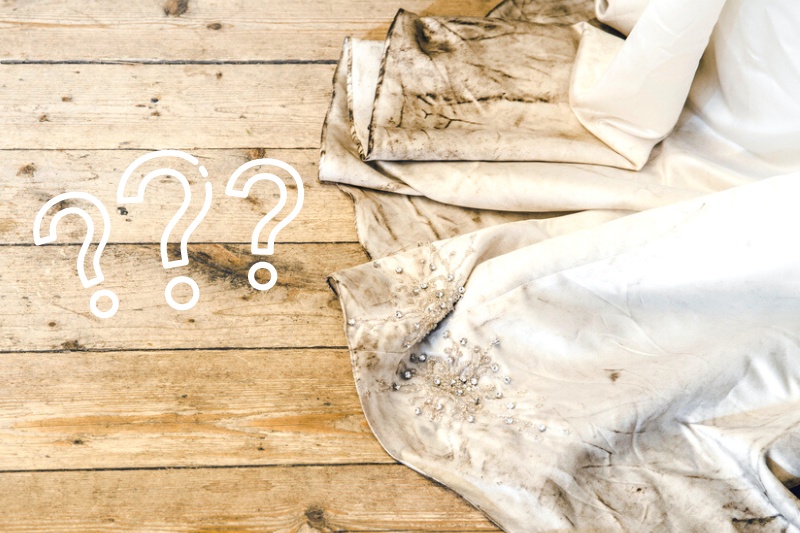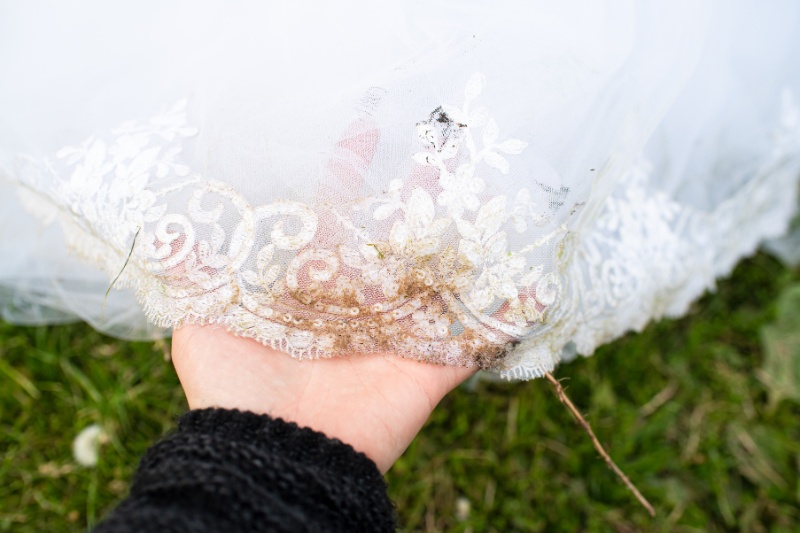For many people, a wedding dress holds the memories of one of the most important days of your life. It symbolises the love and joy between you and your partner and is often kept as a memento or an heirloom to be passed down to future generations.
Unfortunately, wedding celebrations can take a toll on your dress, leaving it a bit worse for wear.
This is why it is so important to be able to take proper care of your dress! By cleaning and preserving the fabric, you can restore your dress’s beauty and keep it in pristine condition.
In this article, we will teach you how to clean a wedding dress safely and effectively.
Whether you’re dealing with intricate lace, delicate beadwork, or flowing fabric, our detailed guide will tell you everything you need to know!
Can You Put a Wedding Dress in the Washing Machine?

When cleaning a wedding dress, many people ask whether you can put it in the washing machine. Unfortunately, this is rarely the case for wedding dresses, as the fabrics and embellishments used will often become damaged in the wash.
However, this isn’t always the case! If your dress meets the two conditions below, it will typically come to no harm in the washing machine:
- The fabric is machine-washable: The first thing to check when cleaning a wedding dress is what fabric it is made of. More durable materials, such as cotton and polyester, can typically be put in the washing machine with no issues. You can always check the care label if you’re at all unsure.
- There are no embellishments: Sections of beading and sequins are usually the main cause of damage when washing a wedding dress, so it’s best to avoid machine washing if you’re dealing with any such embellishments. Sometimes, these embellishments can be removed for washing, so always check before ruling out the washing machine entirely.
If you do decide to put your wedding dress in the washing machine, always place it in a wash bag to help prevent the fabric from becoming tangled or ripped.
You must also use a gentle wash cycle and mild detergent to reduce the risk of any damage.
However, we highly suggest you avoid putting it in the washing machine if at all possible.
It may be more time-consuming to hand wash your dress, but it is the safest option if you’re against getting it professionally cleaned (see below for more details).
How Do You Wash a Wedding Dress?

A wedding dress is an incredibly delicate garment, so you must be careful when cleaning it to prevent any damage. Always check the care label before washing your gown, as some will need to be professionally dry cleaned.
If your dress is suitable for washing, you typically have four options:
- Machine washing
- Hand washing
- Spot treating
- Professional washing services
As we’ve already covered, putting a wedding dress in the washing machine is not the best choice when cleaning such a delicate garment. This is because the fabrics and embellishments used will often become damaged under such harsh cleaning conditions.
Instead, we recommend either taking your dress to a professional cleaner, sport treating the dirtiest areas, or completely washing it by hand. Details on each of these options are given below:
Getting your wedding dress professionally cleaned

The best way of washing your wedding dress is to take it to be professionally cleaned. This is the most costly cleaning method on this list, which might be unaffordable for some (especially after funding an expensive wedding), but it is also the safest and most likely to give you the best results.
Unfortunately, many substances, such as white wine, will dry clear on your dress and be virtually impossible to spot.
These stains will slowly become discoloured and difficult to remove if not treated early. Professional wedding dress cleaners are trained to spot these stains and remove them from the delicate fabric, while they often go untreated if a dress is cleaned at home.
When choosing a professional cleaner, ensure you pick one that specialises in cleaning wedding dresses similar to yours, as this will reduce the chances of any damage occurring.
It’s a good idea to get a guarantee that the cost of the dress and the cleaning will be refunded if anything goes wrong.
Spot treating stains on a wedding dress

If you get a mark or stain on your wedding gown but the majority of it is clean, it is possible to spot-treat that stain rather than wash your whole dress.
As previously mentioned, many stains will not show up on the fabric. However, removing them is still important if possible. Otherwise, they will become extremely challenging to remove later on.
The best way to remove these marks and stains is as follows:
- Step 1: Patch test – Before using a stain remover on your wedding dress, you should perform a patch test. To do this, apply the cleaner to a small, inconspicuous part of the fabric according to the product instructions. If no damage occurs, the cleaner will be safe to use on the stain.
- Step 2: Prepare your dress – If your wedding dress has multiple layers, separate them before applying your stain remover. This will prevent the cleaner from seeping into another part of your dress and transferring the stain. You can also place a paper towel between the layers if you can’t fully separate them to the same effect.
- Step 3: Apply the stain remover – Gently apply the stain remover to the affected area and leave it to sit according to the label instructions. Never rub the cleaner into your dress, as this could damage the fibres.
- Step 4: Rinse and dry the area – After the required time, thoroughly rinse the stain remover from the dress using cold water. Then, dry the area by holding a hairdryer a few inches from the fabric. Leaving the dress to air dry could leave a water mark behind, so it is best to avoid this wherever possible.
According to The Sun, two stain removers proven to give good results when treating a wedding dress are Vanish Oxi Action Stain Remover Powder and Sard Wonder.
Hand washing a wedding dress

Your final option for cleaning your wedding dress is to wash it by hand. This can be quite a lengthy process and requires some attention to detail, so we suggest following the below guidelines for the best results:
- Step 1: Disinfect your bath – Start by thoroughly cleaning and disinfecting your bath before rinsing it with cold water. Although this may not seem important, any dirt or residue in the tub may transfer to your dress during cleaning, so they must be removed beforehand.
- Step 2: Prepare your cleaning solution – Fill the bathtub with lukewarm water and then mix in a little washing up liquid or a mild detergent so that the water is sudsy. If your dress is particularly soiled, you can also add some stain remover to the water, provided you have already tested it to ensure it won’t cause any damage.
- Step 3: Soak your wedding dress – Submerge the dress in the soapy water and leave it to soak for a few hours. Then, massage the fabric to remove any dirt. You can use a soft toothbrush to help clean any problem areas if needed. However, be careful not to scrub too hard, as this can cause holes to form. Remember to check inside the bodice for any marks as well as the dress exterior.
- Step 4: Spot-treat stains – If any stubborn stains remain, spot-treat them as described above. Then, thoroughly rinse the dress in clean water until all traces of dirt and detergent have been removed. Avoid using hot water when rinsing, as this will likely damage the fabric or cause embellishments like beads and sequins to melt.
- Step 5: Dry your wedding dress – Place a fold-up airer on an old towel and then hang the wedding dress over the top. Make sure the weight of the dress is evenly distributed over the rack to avoid any stretching during the drying process. As the entire dress will be wet, you won’t have to worry about water marks like when spot-treating a small area of fabric.
Now that your wedding dress is completely clean, it’s a good idea to preserve it so that it will last for many years. This is always best done professionally, as they can remove the oxygen inside the storage box to prevent the fabric from ageing.
When done properly, this can preserve your wedding dress for 100 years or more!

Hannah has a passion for cleaning. She worked her way around Australia by cleaning hostels in exchange for free accommodation and used her cleaning skills to bag a job as a chalet host for a luxury ski company in France.






